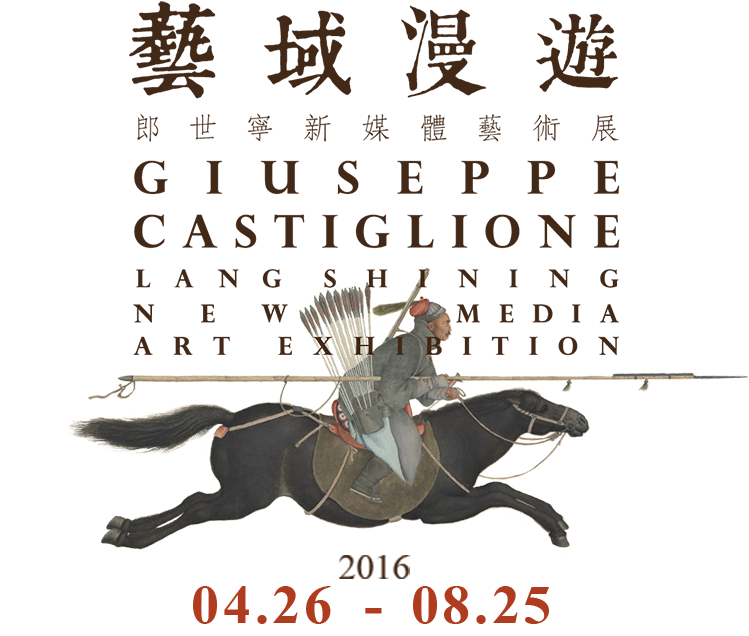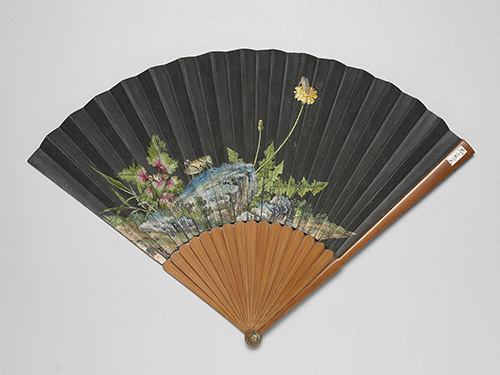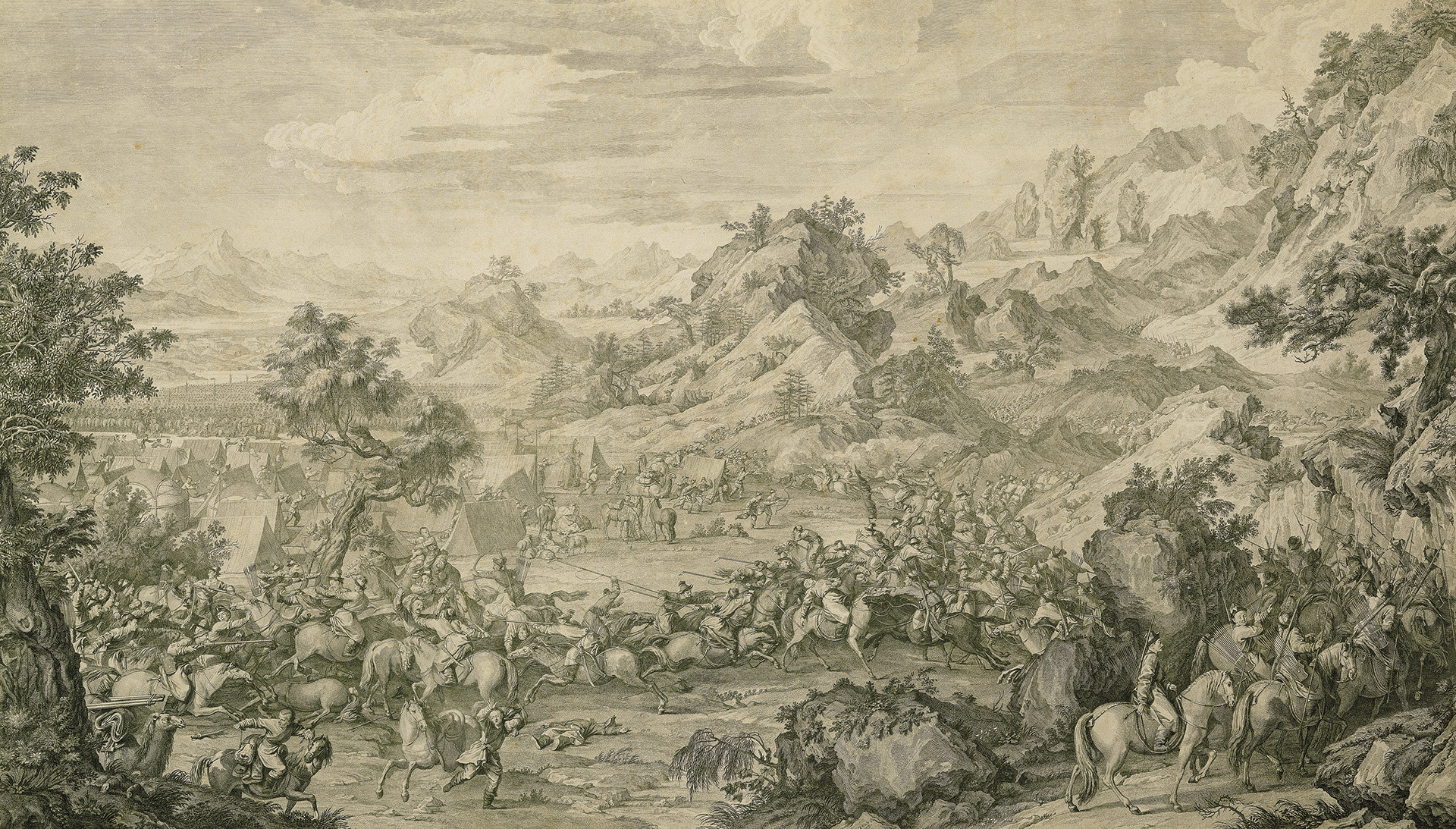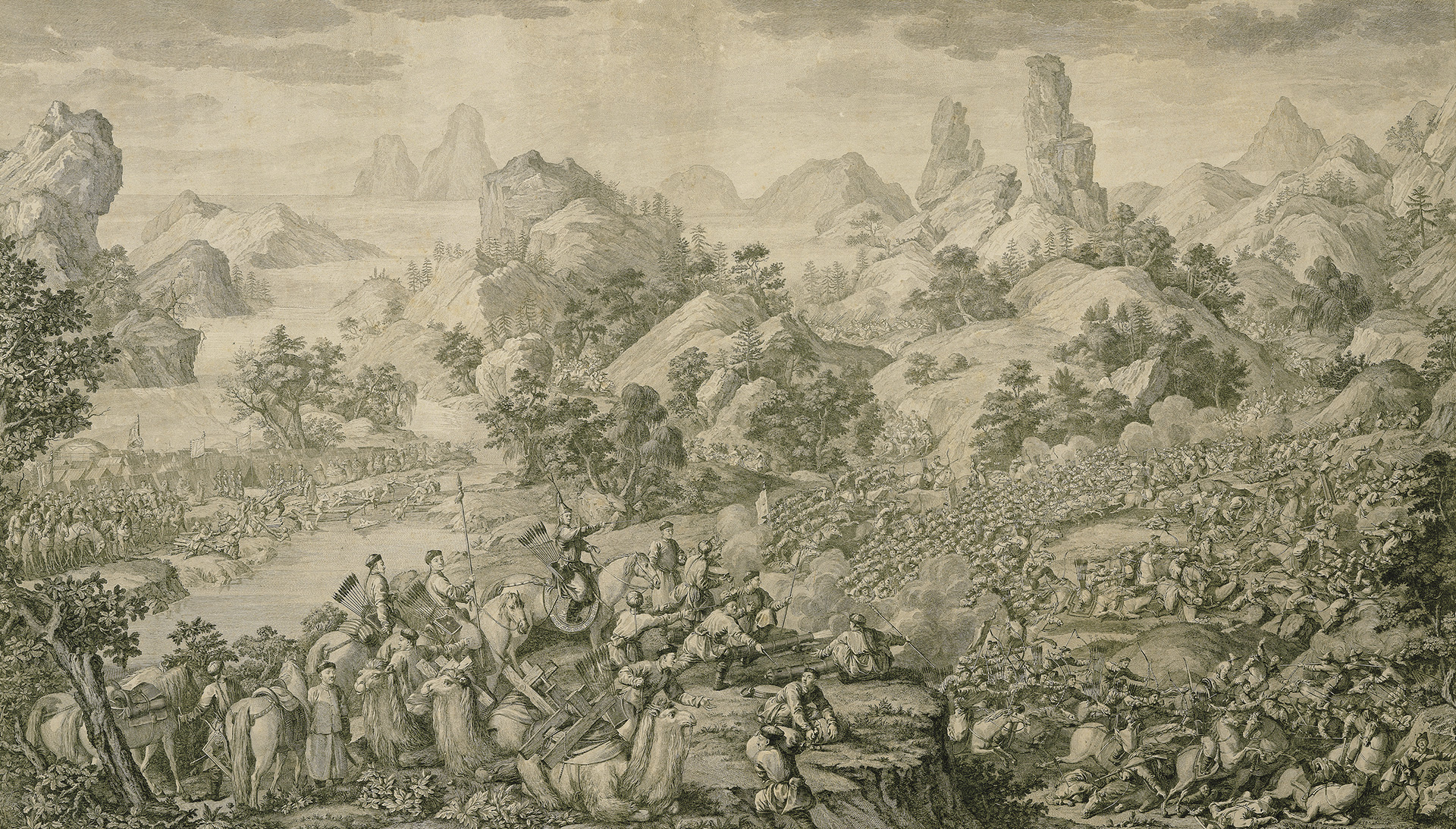Reflections of the Peacock
- Concept and design: N7 communication
- Original work of art: Peacock Spreading Its Tail Feathers
This installation takes Castiglione's painting of two peacocks and separates its iconographic elements into layers that are then individually printed onto a succession of large glass panes. This spatial and optical re-formulation of the painting illuminates the unique fusion of Western single-point perspective and Chinese painterly aesthetics that Castiglione achieved in his work.
Castiglione's Road to China Three Hundred Years' of Memories;Eight Thousand Miles of Travel
- Created by: Victoria Lu, Institute for Information Industry
Viewers are able to learn about the various chapters in Castiglione's life three hundred years ago through videos about Castiglione using touch screens and hand controllers.
Visitors can choose either to watch video clips or download the full video onto mobile devices. The video introduces Castiglione's birthplace, Milan, the cities he travelled to, including Genoa and Coimbra, and his journey to Beijing after he sailed all the way from Lisbon to China. It also includes the remains of the European-style buildings that he helped to design for the Old Summer Palace.
Interactive Folding Fan
- Concept and design: Jeffrey Shaw
- Application software: Mo Luk
- Original work of art: Folding fan with painting by Giuseppe Castiglione and calligraphy by Zhang Ruoai
A 3D computer graphic representation of this fan is shown on a large video screen. It can be interactively folded and unfolded by the viewer by turning a knob mounted on a plynth in front of it.
Folding fan with painting and calligraphy
- Lang Shining (Giuseppe Castiglione, 1688-1766) and Zhang Ruo'ai (1713-1746), Qing dynasty
- Folding fan, ink and colors on paper
- Width: 28 cm
This is the only folding fan painting by Giuseppe Castiglione in the collection of the National Palace Museum. It is painted on dark paper, the coloring bright and beautiful in this intimate scene of flowers and insects. A katydid is on a rock as a bee has been attracted to a dandelion. The flower and its stem are all represented with a bright source of light, while the bodies of the insects are rendered with delicate washes of color. Even the fine hairs of the katydid and its feelers as well as its shadow cast on the rock are all faintly visible. The other side of the fan is a transcription by Zhang Ruo'ai of the second and third months from "Inquiring After Friends in the Twelve Months" by a Tang dynasty calligrapher, the contents seeming to echo the seasonal aspects of the visual imagery. This painting, perhaps an early work by Castiglione, features a strong sense of three-dimensionality for the objects in space, imbuing new meaning to this traditional Chinese subject of "grasses and insects." The folding fan, invented in East Asia, has here been illustrated by a Westerner, also adding special significance to this format.
Discover the Painting in Castiglione's Drawing
- Concept and design: Sarah Kenderdine and Jeffrey Shaw
- Application software: Leith Chan
- Engineering: Huib Nelissen
- Original work of art: One Hundred Horses (The National Palace Museum Collection) Preparatory Drawing for One Hundred Horses (Lent by The Metropolitan Museum of Art, Purchase, Friends of Asian Art Gifts, 1991.134)
This interactive augmented-reality installation gives the viewer the opportunity to directly compare Castiglione's preparatory drawing of "One Hundred Horses" with his final painting. The sketch is exhibited as a full-size printed facsimile, and the viewer holds a tablet in front of it to reveal the superimposed painted scroll. Wherever the tablet is positioned by the viewer, the portion of the painted scroll seen on its screen will be exactly aligned with the printed drawing behind it.
Preparatory Drawing for "One Hundred Horses"
- Lang Shining (Giuseppe Castiglione, 1688-1766), Qing dynasty
- Handscroll, ink on paper
- 94.5 × 776.2 cm
- Lent by The Metropolitan Museum of Art, Purchase, Friend of Asian Art Gifts, 1991 (1991.134)
This handscroll is quite similar in size and composition to Giuseppe Castiglione's One Hundred Horses scroll in the National Palace Museum. This painting, done with a brush, is very likely a preparatory drawing for the final version. Its ink lines can be generally divided into two types. One is used to depict the landscape and plants, in which the ink is darker and the lines more varied in thickness. The other delineates the horses, being in lighter shades of gray with lines thinner than the former. These are using tools that differ from the traditional Chinese line rendering brush. In particular, beneath the lines for the horses there appear to be traces of a charcoal drawing, offering important evidence for understanding the process by which the painting was developed. Overall, the positions and poses of the one hundred horses in both scrolls are very similar, with differences being in places where the drawing was removed and repainted. As for the plants and landscape, here more changes can be seen between the two versions.
One Hundred Horses
- Lang Shining (Giuseppe Castiglione), Qing dynasty
- Handscroll, ink and colors on silk
- 94.5 × 776.2 cm
This handscroll, completed in 1728, depicts a hundred steeds in various poses within a horizontally stretching landscape to create a majestic scene of pasturing. The horizon line for the landscape is maintained at a two-thirds height throughout, creating for a complete and contiguous sense of space across the surface of the painting and the scenery. The trees and other motifs are also shown in correct proportion to suggest a spatial effect of level distance. The technique in the painting differs from that of traditional Chinese art, with the artist, Giuseppe Castiglione, utilizing areas of light and dark colors for the forms to suggest their volumetric quality and to express a sense of light and shadow as well. As for the horses, though their forms are outlined with lines, they are mostly modeled with areas of color. Castiglione, however, consciously subdued the shadows for the forms to preserve their solidity but without creating a dramatic contrast between light and dark. This work can be seen as Castiglione's way of actively integrating the qualities of two disparate painting traditions.
The Emperor's One Hundred Horses: New Media Animation of the One Hundred Horses (Duration: 3'49")
- Created by the National Palace Museum and Digimax Original
- work of art: One Hundred Horses by Giuseppe Castiglione
Giuseppe Castiglione painted many horse scenes. His horses are very life-like thanks to the shadows and fine details that brought painterly realism to a new height. To remain faithful to the original painting, the latest most sophisticated animation technology was utilized to render and vividly portray images of horses engaging in playful activities: nudging each other, resting, galloping and fording.
Interactive "One Hundred Horses" Scroll
- Concept and design: Jeffrey Shaw
- Application software: Mo Luk
- Original work of art: One Hundred Horses by Giuseppe Castiglione
Chinese panoramic scroll paintings were originally designed to be laid on a table and rolled from one end to the other. As a consequence the scroll's iconographic narrative would gradually reveal itself as it passed beneath the viewer's gaze. To reconstitute this manner of reading the over seven-meter long "One Hundred Horses" scroll, this interactive installation lets the viewer with handles with which to unroll a full size digital facsimile of the painting across a video screen mounted in a table.
Everyone can paint "One Hundred Horses"
- Concept and design: Jeffrey Shaw
- Application software: Mo Luk
- Original work of art: One Hundred Horses
Castiglione's "One Hundred Horses" is presented on four large video screens. In front of each screen there is a plinth with a touch screen on which visitors can draw with a digital paintbrush. The horses in the Castiglione painted scroll are initially mostly all white; the visitor can choose any one from the group they are looking at, bring that horse onto their touch screen, and then use the digital paint-brush to color it in. Once finished, the personally colored horse can be sent back into the painting where it will remain for a while before turning white again. As a consequence, the one hundred horses are continuously being repainted during the exhibition by its visitors, who are given the opportunity by this installation to add their creativity to that of Giuseppe Castiglione's.
A Tour of the Imperial Garden:The "Immortal Blossoms in an Everlasting Spring"
- Created by the National Palace Museum and Vick Wang
- Exhibition design: Jeffrey Shaw
- Original work of art: Immortal Blossoms in an Everlasting Spring by Giuseppe Castiglione
Original work of art: Immortal Blossoms in an Everlasting Spring by Giuseppe Castiglione This installation presents four animated films that are inspired by Castiglione's Immortal Blossoms in an Everlasting Spring. These films are projected onto four large screens set in a square, so that viewers who step inside are fully surrounded by the imagery. Due to the optical alignment of these animations the visitors feel as if they are actually walking through a virtual blossoming garden.
Spectral Flowers
- Concept and design: Jeffrey Shaw
- Application software: Leith Chan
- Original works of art: Gathering of Auspicious Signs, Vase of Flowers
This interactive augmented reality installation re-creates Castiglione's painted flowers as spectral 3D objects. On the screen of a hand held tablet, the flowers in vases appear like holograms standing on top of two designated plinths. On each plinth there is a circular printed image - a detail of the flowers - that is used by the tablet as a positional reference so the visitor can walk around the plinth and view the virtual vase of flowers from any angle. The exhibition visitor may also purchase these flower prints, and then, after downloading the ‘Castiglione's Virtual Flowers' app onto their mobile device, they can place and view this augmented reality artwork anywhere they wish.
Another Kind of Chess Game
- Concept and design: Jeffrey Shaw
- Application software: Mo Luk
- Original work of art: Chinese chess board painted on the back with flowers of the four seasons by Giuseppe Castiglione
A 3D computer graphic representation of Castiglione's painted chessboard is horizontally projected onto a low table. The viewer uses an array of sixteen buttons, mounted on a pedestal, to flip each of the board's sixteen segments and thereby create different combinations of its painted and chessboard aspects.
Chinese chess board painted with flowers of the four seasons
- Lang Shining (Giuseppe Castiglione, 1688-1766), Qing dynasty
- Wood chessboard, ink and colors on silk
- 25.9 × 25.6 cm
This painting on silk was pasted on the back of a Chinese chess board. It represents various flowers of the four seasons in a waterside setting, such as the plum blossom, chrysanthemum, lotus, iris, crab apple, peony, bellflower, and begonia. All shown in bloom, the scene complemented by a pair of birds calling to each other. The board pieces are stackable, resulting in the painting being divided into sixteen units that can also serve as individual scenes, demonstrating the artist's skill in compositional arrangement. In the upper right corner is an inscription by Liang Shizheng (1697-1763), who wrote lines referring to the "complexity of beauty in the unity of four" and the "palindrome-like style of the brush," descriptions which befit the arrangement of the chessboard as well. Few of Giuseppe Castiglione's individual works are as small as this one. The dotted lines for texturing the slopes and the use of shadows for the lotus stems indicate that it probably represents his early style. However, Castiglione's signature does not include the character for "Your Servitor (chen)," indicating it was not for the emperor. The painting also shows that he worked in different formats.
Explore Castiglione's Painted Flora and Fauna
- Concept: Jeffrey Shaw (The Linear Navigator 1999)
- Panoramic paintings: Zaffer Chan, Eunice Cheung
- Application software: Mo Luk
- Engineering: Huib Nelissen
- Original work of art: From the works of Giuseppe Castiglione collected by National Palace Museum
In this installation the viewer moves an LCD screen in either direction along rails mounted on the exhibition wall. In so doing they travel across two virtual painted panoramas that are populated with many of the plants, birds and animals that can be found in Castiglione's paintings. Whenever the viewer stops moving the screen, the painting that is being referenced at that particular position in the panoramic landscape will then appear in its entirety on the screen, together with the work's title.
Copperplate Engravings with Sound Effects
- Concept and design: Jeffrey Shaw and N7 communication
- Original works of art: Copperplate engravings of Storming of the Camp at Gädän-Ola and Lifting of the Siege at the Black Water River from Victory in the Pacification of Dzungars and Muslims
This installation provides the exhibition visitor with an embodied and dramatic experience of Castiglione's monumental battle-scene engravings by means of an immersive architectural and acoustic environment that the viewer can walk through.
Copperplate engraving of "Storming of the Camp at Gädän-Ola" from Victory in the Pacification of Dzungars and Muslims
- Sketch drawn by Giuseppe Castiglione
- Directed by Charles-Nicolas Cochin
- Engraved by Jacques Philippe Le Bas
- Printed in Paris, 1769
- 58 × 95cm
This illustration depicted a decisive battle in 1755. General Ayūsi, who was a former enemy surrendered to Qing, took 22 horsemen to launch a surprise attack against the main camp of Dawaachi (?-1759), the Dzungar rebel leader.
The illustration was drafted by Giuseppe Castiglione. We can see Ayūsi, riding a black horse with a lance in hand, stabbed his weapon into an enemy's chest.
The sketch was sent to Paris for engraving in 1775. The project was directed by the famed engraver Charles-Nicolas Cochin (1715-1790), and the craftsman assigned to the task, Jacques Philippe Le Bas (1707-1783).
In 1779 the engraving was completed, and the prints were shipped back to China by the French East India Company the following autumn.
Copperplate engraving of the "Lifting of the Siege at the Black Water River" from Victory in the Pacification of Dzungars and Muslims
- Sketch drawn by Giuseppe Castiglione
- Directed by Charles-Nicolas Cochin
- Engraved by Jacques Philippe Le Bas
- Printed in Paris, 1771
- 58 × 95cm
Known in Mongolian as Karausu, the Black Water River is on the upstream of Xinjiang's Yarkand River. This illustration depicts the story of the Qing general Zhaohui (1708-1764) and his legendary break-out of a blockade. The Qing's fortification is on the left side. General Zhaohui, holding his horsewhip high in the air, is placed at the center. Calm and collected, he is in full armor and directs the soldiers with confidence. On the right side, the reinforcement forces coming to the rescue launch attacks against the rebels from various fronts. The sketch was sent to France for engraving by the master engraver Jacques Philippe Le Bas. The engraving was finished in 1771.
Animation: Adventures of the Mythical Creatures at the National Palace Museum (Duration: 27 minutes)
- Concept: The National Palace Museum, Liu Yu-Shu
- Animation Production: The White Rabbit Entertainment, Inc., Animaze Studio
Animals featured in Castiglione's paintings burst into life in this 4K animation, the first of its kind that the National Palace Museum has produced. In this short film, the valiant dogs from Ten Fine Hounds and Long-haired Dog Beneath Blossoms take off on an adventure with the lemur from Cochin Lemur and the deer from Auspicious Roe Deer. By using the special powers of the ten dogs, the animals manage to overcome a series of obstacles and eventually come to appreciate the spirit of Castiglione's art, a unique combination of Chinese and European techniques. The 4K-resolution animation, created by some of Taiwan's best animators, brings out the full beauty of Castiglione's art.
Documenting Victory in Etching: A Documentary about Giuseppe Castiglione's Art and Emperor's Victorious Engravings (Duration: 35 minutes)
- Concept: The National Palace Museum, udn production
- Original work of art: Victory in the Pacification of Dzungars and Muslims
This documentary relates the story of the greatest art creation project of the 18th century between China and Europe. In order to accurately reconstruct the historical context in which the engravings of Victory in the Pacification of Dzungars and Muslims were produced, the curatorial team at the National Palace Museum researched historical records in several countries. The team viewed prints housed in the BibliothПque Nationale de France and original copperplates housed in the Ethnologisches Museum, Germany, and filmed engraving techniques at a printing workshop.
Giuseppe Castiglione in China:Imperial Painter, Humble Servant (Duration: 26 minutes)
- The documentary is kindly provided by the Kuangchi Program Service, Taipei
The story of how an Italian Jesuit missionary became a court painter serving three Qing emperors is one of passion, conviction and creativity. Through his artistic innovations and devoted service, Giuseppe Castiglione wrote a unique chapter in the history of Chinese art and built bridges of understanding between Chinese and Western cultures. This documentary depicts the life of Castiglione from a modern perspective, attempting to unveil the inner world of this missionary and to delve into the East-West cultural exchange process.
Mobile App: Castiglione
Using iBeacon and 4G/LTE mobile network technologies, this app enables users to experience guides, video and interactive content for the exhibition on their own mobile device. The app is a collaboration between the National Palace Museum, City University of Hong Kong and the Institute for Information Industry in Taiwan.






